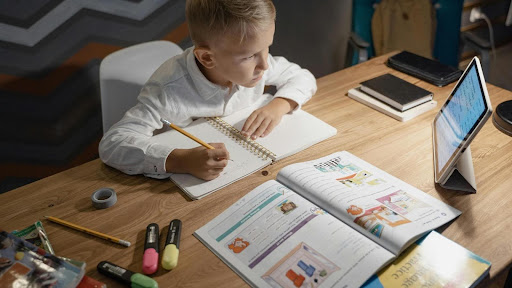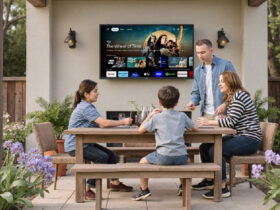Kids today learn differently than we did. They’re growing up with tablets, smartphones, and computers as natural parts of their world. When we think about education, we can’t ignore how these digital tools are reshaping the way children absorb and process information.
The shift toward digital learning isn’t just about convenience—it’s about creating more engaging, personalized experiences that stick with young learners. Online courses help students retain 25% – 60% more knowledge than traditional classroom learning. This dramatic improvement in retention shows us that technology in education isn’t just a trend—it’s a powerful tool that’s transforming how kids learn and grow.
How Digital Tools Transform Traditional Learning
The days of passive learning are fading fast. Children don’t just want to read about science experiments—they want to conduct them virtually. They don’t just want to hear about history—they want to walk through ancient civilizations using virtual reality.
-
Virtual Reality Brings Subjects to Life
Virtual reality has moved beyond gaming into education, creating immersive experiences that make abstract concepts tangible. Kids can explore the human body from the inside, visit the International Space Station, or witness historical events unfold before their eyes. These experiences stick because they engage multiple senses simultaneously.
-
Gamification Makes Learning Addictive
Educational games tap into children’s natural love of play and competition. When math problems become quests to save a kingdom, kids don’t realize they’re doing homework. These platforms track progress, award achievements, and create a sense of accomplishment that traditional worksheets simply can’t match.
-
Simulation Software Provides Safe Practice
Complex procedures become approachable through simulations. Kids can perform chemistry experiments without dangerous chemicals, practice surgical techniques on virtual patients, or run entire cities through simulation games. This safe environment encourages experimentation and learning from mistakes.
This transformation connects naturally to more personalized approaches. Many parents are discovering that online tutoring platforms combine the best of both worlds—human connection with technological innovation. These services often use interactive whiteboards, screen sharing, and real-time collaboration tools that make distance learning feel immediate and engaging.
Real-World Applications That Engage Young Minds
Hands-on learning for kids takes on new meaning when technology removes traditional barriers. Children can now experience things that were once impossible or impractical in a typical classroom setting.
-
Interactive Science Experiments
Digital labs allow kids to mix chemicals, observe reactions, and repeat experiments as many times as needed. They can adjust variables, test hypotheses, and see immediate results without the mess or safety concerns of physical labs.
-
Virtual Field Trips and Exploration
Geography becomes an adventure when kids can virtually hike through rainforests, dive into ocean trenches, or climb mountains. These experiences create lasting memories and emotional connections to places they might never visit in person.
-
Creative Arts and Design Projects
Digital art tools, music production software, and animation programs give kids professional-level creative capabilities. They can compose symphonies, create animated movies, or design architectural structures—all from their computers.
These applications represent just the beginning of what’s possible when technology meets education.
Benefits That Matter to Parents and Educators
The benefits of online education extend far beyond convenience. These advantages directly impact how children learn, grow, and develop critical thinking skills.
Personalized Learning Paths
Every child learns at their own pace, and technology finally makes individualized education scalable. Adaptive learning platforms adjust difficulty levels in real time, ensuring kids are neither bored nor overwhelmed.
Immediate Feedback and Assessment
Traditional homework might take days to return with feedback. Digital platforms provide instant responses, allowing kids to correct mistakes immediately and reinforce correct understanding.
Accessibility for Different Learning Styles
Visual learners get rich graphics and animations. Auditory learners benefit from narrated content and sound effects. Kinesthetic learners can interact with touchscreens and motion sensors.
Technology accommodates all these preferences simultaneously.
These benefits create a foundation for more engaging educational experiences that capture children’s attention and imagination.
Interactive Tools That Make Learning Stick
Interactive learning tools have revolutionized how we think about engagement in education. These aren’t just digital versions of old teaching methods—they’re entirely new approaches to learning.
-
Augmented Reality Overlays
AR apps can turn any space into a learning environment. Point a tablet at a book, and dinosaurs leap off the page. Hold a phone up to the night sky, and constellation information appears.
These tools blend digital information with the physical world.
-
Collaborative Digital Workspaces
Online platforms allow kids to work together on projects regardless of physical location. They can share documents, create presentations, and solve problems as a team. This collaboration teaches important social skills while reinforcing academic concepts.
-
Adaptive Quiz Systems
Smart quizzing platforms learn from each student’s responses and adjust future questions accordingly. They identify knowledge gaps and provide targeted practice, making study time more efficient and effective.
The combination of these tools creates online learning experiences that feel natural and engaging to digital natives.
Creating Memorable Learning Moments
Technology’s greatest strength lies in its ability to create moments that stick in children’s minds long after the lesson ends.
-
Storytelling Through Interactive Media
Educational content becomes memorable when wrapped in compelling narratives. Interactive stories let kids make choices that affect outcomes, teaching cause-and-effect relationships while maintaining engagement.
-
Problem-Solving Challenges
Complex problems become manageable when broken down into interactive challenges. Kids can tackle environmental issues, historical mysteries, or mathematical puzzles through guided discovery processes.
-
Achievement and Progress Tracking
Visible progress motivates continued learning. Digital badges, progress bars, and completion certificates give kids tangible evidence of their achievements and encourage them to push further.
These memorable moments transform learning from a chore into an adventure.
Common Questions About Technology in Kids’ Learning
-
How is technology used in online learning?
One of the greatest tools for online learning is a Learning Management System (LMS). These systems help educators and businesses with online modules, quizzes, and curriculum. Users can create easy-to-follow modules that methodically take students through the material at their own pace.
-
How can we design hands-on learning experiences?
You can create a hands-on learning experience by: Designing activities that put skills into practice. Do this by creating tutorials, challenges, and practice assignments. For every concept
you’re trying to teach, think about how you can create opportunities for your learners to apply those concepts.
-
What age is appropriate for technology-based learning?
Children as young as 3-4 can benefit from age-appropriate educational technology. The key is choosing tools designed for specific developmental stages, with proper supervision and balanced screen time that complements other learning activities.
Looking Ahead: The Future of Learning
Technology isn’t slowing down, and neither should our approach to education. The tools we have today are just the beginning of what’s possible when we combine human creativity with digital innovation.
The most successful educational experiences will continue to blend the best of both worlds—the personal touch of human instruction with the limitless possibilities of technology. As these tools become more sophisticated and accessible, we’ll see even more creative approaches to engaging young minds.















